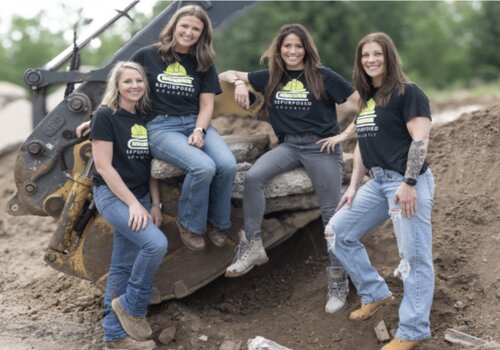People are spending more time researching products and companies online. That’s why it has become so important to have up-to-date information in all the right places.
There is also an opportunity to leverage online information — commonly referred to as marketing content — to establish brand voice, reinforce a reputation for expertise, and enhance the overall image of the company.
This is where the concept of “storytelling” comes into play. Do not be intimidated by that word. An effective “story” does not have to be a 10,000-word masterpiece. When done effectively, an amazing story can be told with nothing more than a nice photo and well-crafted caption.
“A really good story is really about characters,” says Kelly Hambly, managing director of content for Q4 Impact Group, an Ohio-based marketing agency. That is why you see a lot of construction companies posting a lot of photos, videos and other content about employees. Celebrating employees is an effective way to humanize a company while also boosting internal pride.
“Don’t be afraid to have some fun,” Hambly advises. People like to be entertained, especially in today’s digital world where people are exposed to more information from more sources than ever before. Marketers need a way to break through the clutter and make a connection. Playing to emotions can help.
Where can construction companies tell their stories?
Website. “A construction company’s website is its first line of defense,” Hambly says. “It’s important to make sure that the messaging on your website speaks to who you are as a company and the value you add for customers.”
Social media. Numerous social media channels – especially Facebook and Instagram – have become staples in an online marketer’s toolbox. LinkedIn has also proven effective for many in the construction industry. Companies and individuals can easily share timely information, pump up their people and establish their brand voice.
“Social media is an amazing place to engage your customer base, employees and the community — because everybody is on it these days,” Hambly says. “Growth can be extremely fast when you do it right, like when using the right keywords (see hashtags below).”
E-newsletters. Construction companies can regularly email valuable information to their customers. First and foremost, utilize your website to help collect email addresses. Then your e-newsletters can be used to share timely information like product updates and specials. You can also use e-newsletters to help support broader marketing campaigns, as well as communicate internally with employees.
- Hambly says it’s important to incorporate video into your website these days, along with social media. Video is an effective way to present case studies and customer stories. You can also use video to help recruit and train employees.
“If you have a social presence but are not using video right now, don’t get too worried,” Hambly reassures. “You don’t need a big budget and you don’t have to hire an advertising agency. You can just use your smartphone. There are easy ways to tell short, engaging stories that help make a human connection and bring pride to what you’re doing every day.”
- A blog is one of the first online marketing-content tools a company had at its disposal many years ago. Hambly says a blog is still great to have on your website — if you have someone who likes to write and will stay on top of it.
“A blog helps you become a voice of your industry and build some brand authority,” Hambly says. “Then you can incorporate your blog across other channels, including e-newsletters and social media.”
- A hashtag (#) is a simple way to “categorize” your pieces of content with keywords so people can easily find all sorts of social media posts and content around a certain topic. For example, #conexpoconagg or #ConstructionJobs. “Hashtags help you achieve a lot of organic growth on social media,” Hambly says.
Should employees help tell stories?
There are two general ways to go about creating and distributing content. One is to have a dedicated marketing person or smaller team handle it. That helps with control and accountability. But you can also encourage other employees to help tell the company story.
There are benefits to both approaches. But when you allow everyone to play a role in storytelling, there definitely needs to be some guidance.
Particularly in the construction industry, there needs to be some stringent guidelines around content and social media posts that dovetail with safety, regulations and the company’s values.
“Posts need to be very thoughtful,” says Katie Woodhall, managing director of operations for Q4 Impact Group. “It can become a free-for-all where people are just posting whatever they want. At the end of the day, the company is still responsible because it all becomes part of the company story.”
For example, if an employee snaps a photo on a jobsite that shows something unsafe, the post could ultimately result in an OSHA fine. Additionally, the photo can damage the company’s reputation because the photo becomes part of the company story — a story now suggesting that standards and safety are not part of the company culture.
When something potentially damaging does get posted, Woodhall says it’s important for the company to own it. Of course, you could quickly take the post down. Other tactics could be to add a caption or footnote acknowledging it. For instance, let’s say someone posted a photo of an employee sitting in the seat of a wheel loader. The employee had all of their PPE on and gave an excellent, camera-friendly thumbs-up. But the employee did not have the seatbelt fastened around them. Perhaps the caption could acknowledge that, followed up by a disclaimer that the photo was taken before the employee started up the equipment and got to work.
A few more tips to help tell your construction company's story
Humanize the company. Show gratitude for the hard work people are delivering. “You don’t have to overengineer this kind of thing,” Hambly points out. “It is very raw and in the moment, and people will connect because it’s all about the story of the people.”
Show community engagement. This goes beyond those big Habitat for Humanity projects you might be involved in. It’s any kind of thing your company or its people are doing in the community that helps build your brand and tell a story.
Illustrate the work being done. A popular tactic in the construction industry is to show photos of dirty boots, hard hats, employees in hi-vis safety gear, equipment parked with a gorgeous backdrop, etc. These types of storytelling posts aren’t necessarily about the projects themselves. They are more about the people, equipment and processes that bring those projects to life and instill pride in your company.
Start with one channel and one message. Q4 Impact has seen tremendous results with Instagram in the construction industry. Photos can be so powerful. A good caption helps make it even more powerful. So if you’re wondering where to get started, Instagram is a good bet.
From there you can branch out little by little as you become more comfortable. Remember, storytelling isn’t about volume. Storytelling is about consistency. “When people start checking you out online, they soon come to find out that what you have to share is meaningful,” Hambly says. That is when you can start to gain some traction, expand your audience, build your brand voice and enhance your image.
This article is based on a presentation given at CONEXPO-CON/AGG 2020. Q4 Impact Group is a marketing agency based in North Canton, Ohio, with specialties in creative branding for manufacturers and suppliers in industries including mining and agriculture.
Join more than 40,000 industry peers who receive construction industry news and trends each week. Subscribe to CONEXPO-CON/AGG 365.












